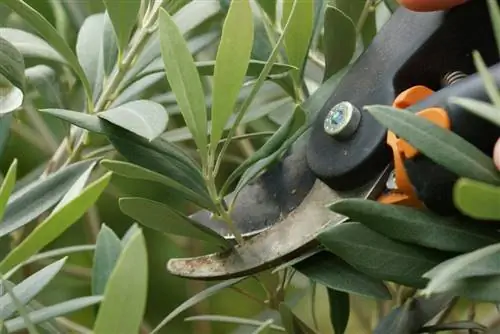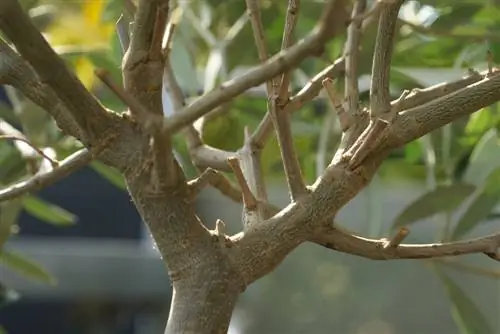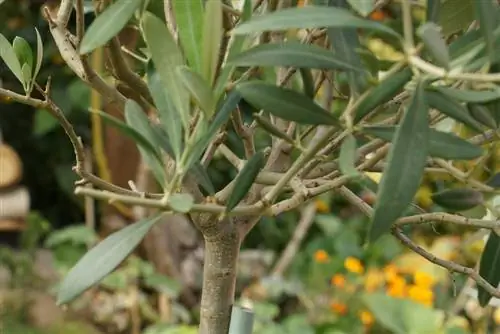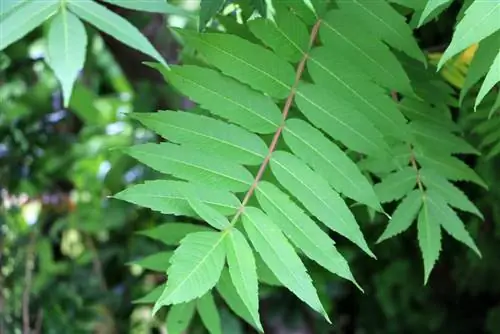- Author admin [email protected].
- Public 2023-12-17 03:39.
- Last modified 2025-01-24 12:45.
Whether the olive tree is in a pot or has been planted freely in the garden, correct cutting is important. And a lot of things can go wrong. The following instructions show how it can be done quite easily.
Is a cut even necessary?
In its homeland, the olive tree thrives without pruning or is only thinned when necessary and to maintain he alth. This gives it a particularly rustic and original shape, which makes it an eye-catcher. Basically, it is not necessary to attack the olive tree with scissors. However, if you decide against offcuts, you will need plenty of space. In this form, a planting distance of at least seven meters is required. Cultivation in a bucket is therefore not possible for long and even the garden has to offer a lot of free space. Cutting the olive tree not only has a visual effect, but is also practical as it keeps the plant at a tolerable size.
The he alth of the tree
If branches or shoots are broken, wilting or show signs of disease, they must be removed immediately. In the local climate, the olive is already more susceptible to diseases. If there are unclean wounds or infestations that have already begun, quick intervention is advisable. For this reason, such care is essential, as are regular checks.
If you want to do something extra good for the tree after removing damaged or diseased parts, use a special wound closure. This effectively prevents pathogens or parasites from gaining access to the more vulnerable interfaces. This type of blend can and should be done all year round.
Blending
Especially after budding in spring, it may be necessary to thin out the olive tree. This is always the case when:
- crossing branches or twigs
- branches grow inwards
- very long, thin and weak shoots appear
- there is strong compaction within the crown
As a rule, the weaker and still green shoots should always be removed, while the older and thicker branches remain. The olive tree requires a lot of strength to woody young shoots. If there are too many of them on the tree, it can quickly become exhausted. This in turn leads to excessively thin and puny growth.
When can the olive tree be trimmed?
As mentioned above, the removal of diseased plant parts can and should always be done all year round if necessary. Otherwise, disease germs and pests will have too long an opportunity to spread through the olive tree from the damaged areas. However, even gentle cuttings for thinning should only be carried out in spring. This is important and sensible, as local winters already demand a lot of strength from the olive tree. Even if they are protected in the winter garden or another frost-free room. Because the natural and original conditions simply cannot be recreated perfectly. If the tree is pruned in the fall, in addition to the stress of the winter, there will also be a loss of strength due to the pruning. This weakens the Mediterranean plant unnecessarily and can possibly lead to damage or even death. Therefore, all major pruning measures, including the following topiary, should only be carried out after the last frost in spring. This way the olive tree has enough time to close the wounds and recover from the treatment.
The right topiary
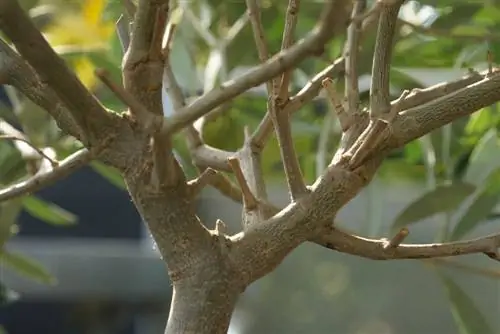
If you decide to cut the olive tree into shape, there are a few things you should keep in mind.
- Wait for the last late frost and the first budding. For olive trees grown in containers, only carry out a topiary cut when the plant can be put outside again.
- Identify the main shoot of the tree. This must remain standing and may only be shortened slightly. It should always be longer than the main branches extending from it.
- Find the main branches and bring them evenly to one length. It helps to use, for example, a tree protection screen or a circle made of thread on the ground as a guide.
- Starting from the main branches, shorten and thin out fresh, young shoots.
- Provide large cuts with a special wound closure. Alternatively, they can be rubbed with water.
The aim is to give the crown the lightest possible appearance and an airy but still round shape. This may take a few tries and requires both practice and patience. Therefore, cutting should be done tentatively at the beginning rather than radically. The olive tree usually recovers even after severe pruning, but errors can only be corrected gradually due to the rather slow growth. However, a recut is always possible.
Frequency
The olive tree grows relatively slowly. The low growth leads to a rather rare blend. However, this can prove to be disadvantageous. The longer the tree remains uncut, the more likely it is that compactions and problem areas will creep in. This in turn requires radical interventions. It is much better to shape the olive tree annually. Starting with very young plants. This means that only slight shortening and thinning is required, which is much gentler. And even though it may not seem like it, the effort itself is reduced to just a few cuts. Annual shortening has the additional advantage that the branches overall become more lush.
Care after cutting
The formation of new shoots and the lignification of them requires some strength and therefore a larger amount of nutrients and water. The same applies to the loss when cutting the olive tree. Immediately afterwards, it should be given plenty of water and a highly diluted fertilizer. Phosphate-rich fertilizers in liquid form, which are mixed directly into the irrigation water, are suitable.
What you should know in brief
With a little practice and following a few tips, pruning an olive tree is easily possible, even for amateur gardeners. If you prune regularly and carefully, you will soon be able to enjoy a stately and well-shaped Mediterranean tree.
Various cuts
- After planting, pruning is carried out to change the shape of the tree crown.
- There is also circumcision for renewal, the regeneration cut.
- Old trees are sawn down to the stump. A few strong shoots from the stump are selected and left standing.
- The cut for optimal oil extraction is done immediately after the frost period, as the frost would make it more difficult for the scars in the wood to heal.
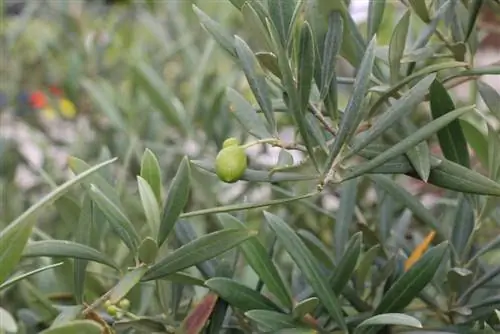
When cutting, the inner area is cut free of small branches. Basically, anything that grows inwards is cut away. Regrowing shoots in the root area and forks should be removed regularly all year round. Otherwise these shoots will rob the olive tree of its strength.
- If you want a fruit yield, you should only prune your olive tree once a year, after the harvest.
- To obtain a beautiful trunk, all shoots and branches below the desired branching point must be removed.
- When cutting back, you should make sure that the last eye always faces outwards.
Time of pruning
It is true that an olive tree can be pruned all year round, but you have to keep in mind that your olive tree in Germany will not get the warmth that it is used to in its homeland. This does not change its basic growth behavior, so you can still use the scissors throughout the season if necessary, but it usually grows significantly less here. That's why you should also hold back when cutting:
- Once the basic shape has been determined, an olive tree in a pot only needs to be pruned once a year, and only just enough so that it retains its shape.
- In Germany, basic pruning is best done in spring.
The recommendation of this time also has a reason: the olive tree doesn't overwinter here as it would like, it gets too little light and too little heat, even in the brightest room. This means that it is under a lot of stress in the winter, and you shouldn't increase that by giving it its main cut in the fall. Rather, it is allowed to move in all its glory to its winter quarters, where it remains until it has enjoyed so much spring sunshine and spring warmth that it begins to sprout. Then he is circumcised according to his wishes and purpose.
Tips for speed readers
It all depends on what your purpose is:
- If you want the olive to develop as many flowers as possible, you have to cut back all around - flowers will only appear on the new shoots.
- Otherwise, the cut should promote the development of a crown that is as stately as possible, so you cut away all annoying branches all around and follow the natural crown shape.
- You would have to be careful not to cut the main shoots, which form the actual “framework” of the tree crown.
- The main shoots should remain longer overall than the side shoots, so a cheeky side shoot should be cut back.
- All fresh green branches that grow too close to others, crossed, inward or otherwise strange (e.g. too thin) should disappear.
- All dead or otherwise sickly-looking shoots are also cut away.
After pruning the olive tree, you should allow it to rest in a shady location for a few days, as it has just moved back outdoors and needs a little time to get used to the light. It can then be moved to the sun. When the olive tree shows new shoots again after the cut, it is watered more heavily and fertilized regularly again. You should remove the shoots that grow out of the root area throughout the year; they only cost the tree energy.

